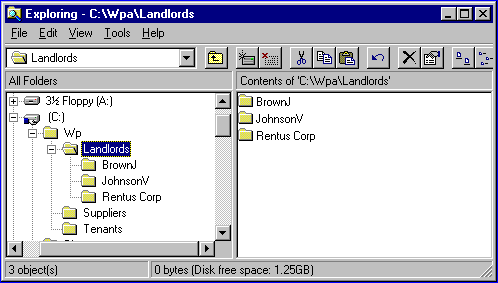Saving Reports So You Can Find Them
First.....Prev.....Next.....Last
One of the problems many users get into with computer systems is they have no plan about saving things to the disk. They either use the default that the package software provides or just "chuck" it all into one spot. This makes it hard to find the exact file you want. Just which one of those 5 or 6 files labelled Smith1, Smith2 etc is the one I want?
To explain a method you might like to adopt I am going to use word processing (WP) as my example. WP application packages have a default working directory at which they aim all saved documents. This means they all go into one bucket, often "My Documents", unless you do something about it. The default can be changed by you and is usually found under User Preferences or Options or some such term.
Because I don't like the many directory levels many applications use I would create a directory directly below the main directory (C or D or E ...) on the disk and name it, would you believe, "Wp". This makes things easy to find when I'm doing WP and also to locate for my back-up routines. Inside Wp (the equivalent of your filing cabinet) I would then create further directories for each major correspondence grouping such as IRD and GST, Debtors, Creditors, (your filing drawers) and then a directory for each entity I deal with (your file hangers)and inside here is where a separate file resides for each document sent in and out (your paper document). Obviously you can have less levels or more levels to suit the way you work.
The structure below shows a possible property management structure which could be misleading because the Aspect Property Manager handles all the correspondence if you make use of it. I am disappointed when I find users running external systems which means information is scattered around. It would be like filing inspection letters to a landlord in one filing cabinet but other correspondence in another cabinet in another room.

When saving a WP document to landlord Joe Brown do this. Select File > Save As > and then locate the directory Wp > Landlords on the directory structure. There is normally an option to create a new directory if the one wanted does not exist. The file saving and directory creation method varies with the word processor. Call this new directory BrownJ or Brown Joe (my preference).
Change directory to Brown Joe and save the file with the name "2011-02-23" or "2011-02-23 Painting". By using a reverse date naming system the latest file should be last one in the list.
When naming files try and be consistent. To space or not to space, hyphenate or not is a question for you to answer. If you miss don't separate by spaces or hyphens consider making the h a capital.
I have used WP as an example but would not expect you to set up directories for most documents associated with the Aspect Property Manager because they are catered for within the software. However, if you apply the same method to reports and other files you may want to save for future reference it will work too. The variations are limitless so you need to set it up to suit you.
Note
When you create letters in the Aspect Property Manager, as well as saving them in the recipient's Correspondence File within the database you may also save them to disk. By default the "save in" directory will be ...\PropMan\Reports\Letters\Landlords (or Tenants or Suppliers) directory. See Letter section of the Mail topic.
Two suggestions in creating the directories. One is to avoid having too many levels and big names. It makes things you are regularly using unwieldy if you need to type some 50 plus characters just to save a letter. Compare my Wp path to the original default set in Outlook "C:\Documents and Settings\Peter\My Documents" which is 4 levels deep before you start putting any structure of your own in place. The other suggestion is not to save files directly in the root directory or top directory in a partition. The operating system stores special files there and it is too easy to accidentally delete them. Then "things don't work Papa".
Finally, there is no definitive right way. Just have a consistent method.
